La reflexión pictórica de Alfonso Albacete / The pictorial reflection of Alfonso Albacete

Alfonso Albacete (Málaga, 1950) es uno de los pintores más relevantes del arte contemporáneo español a día de hoy. Su obra ha sido expuesta en numerosos museos y galerías, teniendo el placer la Galería Ana Serratosa de poder incluirse entre ellas.
Este artista de origen andaluz, que pasó la mayor parte de su infancia en Murcia, fue discípulo del artista Juan Bonafé. Esto, unido al hecho de crecer junto a la costa levantina, harán de la luz y el color elementos fundamentales en su obra.
Albacete cuenta además con una formación en arquitectura. Aunque terminó sus estudios, nunca llegó a ejercer de manera profesional, pues tan solo dos años después de licenciarse presentó su primera gran exposición individual en Madrid. Con ella recibió un gran abrazo de la crítica y la oportunidad de dedicarse completamente al arte de manera profesional.
Durante sus primero años tuvo una breve etapa conceptual, como muchos artista de su generación, pero pronto se decantó por la pintura, donde cuenta con una prolífica trayectoria.
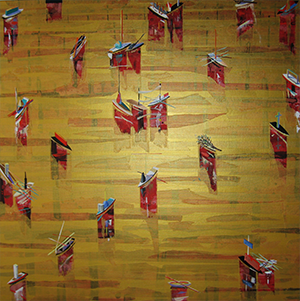
Alfonso Albacete - El mar de la china, Dorado - Galeria Ana Serratosa
Alfonso Albacete y su generación
Alfonso Albacete pertenece a una generación de pintores españoles que comenzaron sus andaduras a principios de los 70. En todos ellos se aprecian claros estilos personales que los hacen fácilmente diferenciables, pero también están presentes ciertos elementos comunes.
Es frecuente el uso de una paleta de colores vibrantes, así como un discurso apolítico en sus obra. Todos ellos apostaron por la pintura como medio de expresión, refiriéndose a ella con mayor o menor intensidad dentro de su obra.
En el caso de Albacete, la reflexión sobre la pintura es constante, y ha ido ganando intensidad con el paso de los años.

Alfonso Albacete - Destiempo 13, Primera siesta
Principales características de sus obras
Como ya hemos comentado, dentro de la generación de Alfonso Albacete existen varios artistas como Villalta, Gordillo o Manolo Quejido con unos estilos personales muy claros y diferenciadores. Por ello nos centraremos en destacar aquellos aspectos que resaltan dentro de la obra de Albacete.
El autor reconoce que el componente lumínico es una de las claves dentro de su obra. En ella predomina una luz blanca, propia del levante español, y que recuerda en más de una ocasión a los cuadros del también levantino Sorolla. Gracias a este elemento, Albacete consigue hacernos reflexionar sobre el paso del tiempo, así como dotar al cuadro de la vitalidad tan propia de su estilo.
Otro elemento a destacar es el uso de una paleta de colores vivos, tan recurrente entre su generación. Albacete tiende a sobresaturar esta paleta, como muestra de su admiración por culturas asiáticas como la India.
Para el autor, la relación entre lo real y lo imaginario es lo que se produce dentro de la obra, por lo que su estilo presenta ese equilibrio entre la figuración y abstracción que tanto lo caracteriza.
Por último cabe señalar que el uso de la figura humana en sus obras no es de una manera directa, sino simbólica. No pretende que se conviertan en el centro de atención del cuadro, sino una parte más dentro del mensaje. Es por ello que se representan figuras sin cara, desnudas o difuminadas, despojándolas así de los prejuicios del que mira.
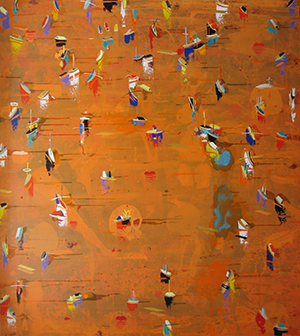
Alfonso Albacete - El mar de la china, cadmio - Galeria Ana Serratosa
Principales influencias artísticas en sus obras
En la obra de Alfonso Albacete se pueden encontrar referencias muy variadas. Algunas son muy claras y directas, como puede ser la importancia de la luz de Sorolla, pero otras necesitan una reflexión más sosegada.
El padre del artista se dedicaba al mercado de la seda, lo que supuso que a lo largo de su infancia recibiera visitas de mercaderes asiáticos con cierta frecuencia. El impacto de ver a empresarios de Japón o India en un niño de la España rural de 1950 sería extraordinario, lo que terminó despertando un temprano interés del artista por estas culturas.
Los colores sobresaturados son un claro reflejo de estas culturas, que llegarán a expresarse de una manera más clara en colecciones como “El mar de la China”, o en aquella dedicada a los jardines japoneses.
También podemos apreciar influencias de los expresionistas abstractos, con una figuración que tiende a abstraerse, o con la clara importancia de la luz en sus obras.
También se muestran trazas del Pop Art, Duchamp o incluso Pollock , con las recurrentes salpicaduras de pincel tan presentes en sus cuadros.
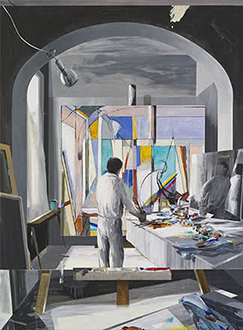
Alfonso Albacete - Natura trece, Especulacción - 2013
Temas presentes en sus cuadros
Uno de los aspectos a destacar dentro de la obra de Alfonso Albacete es la temática, que se mantiene constante a lo largo de los años. En ella se ve una clara influencia de sus primeros años de arte conceptual, al trabajar minuciosamente sobre el concepto y el boceto antes de ponerse a representar.
La temática que más lo caracteriza es la reflexión sobre la pintura, cuyo fin es expandir sus límites. Como muestra de ello encontramos la figura del estudio del pintor que se repite a lo largo de los años. Albacete nos muestra la realidad que se produce dentro del estudio, el proceso creativo que tan frecuentemente tendemos a idealizar.
Otro de los elementos que aluden a esta temática son las pinceladas salvajes, o los intencionados chorretones, que nos recuerdan las materias primas con las que trabaja el artista y las vuelve más presentes.
Por último no podemos olvidarnos de la metapintura que tanto a repetido a lo largo de los años. Con ello nos referimos al hecho de incluir cuadros antiguos en sus obras, lo que vuelve a jugar con la idea del tiempo, y el trabajo del artista como creador.
También es importante señalar la recurrencia del paisaje en su obra. Estos paisajes suponen recreaciones de momentos o vivencias pasadas, donde se emplea de manera recurrente la línea del horizonte, así como la orilla del mar.
Por último, no podemos pasar por alto el uso de la naturaleza muerta por medio de bodegones, ya sean clásicos o más actuales que sigue presente desde sus inicios. Estos bodegones funcionan como guiños para el espectador, que lo acercan al proceso de creación y lo ubica en el tiempo.
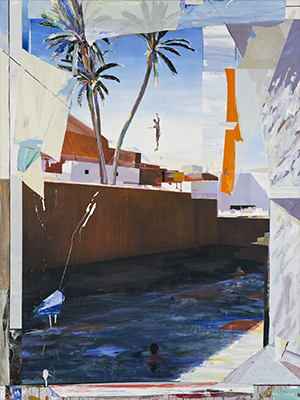
Alfonso-Albacete-Variante-2016
Análisis de sus obras más representativas
Como ya hemos señalado, Alfonso Albacete cuenta con una larga producción pictórica. Es por ello que hemos querido comentar algunas de sus obras más conocidas, para así poder conocer la artista más al detalle.
En el estudio
En el estudio podría considerarse como una de las obras más representativas de su trabajo, en parte porque es la que le dio a ser conocido a un mayor público, y por otro lado porque reflexiona sobre un tema muy frecuente en su discurso: el proceso creativo y la figura del pintor en pleno proceso de creación.
Esta obra se caracteriza por sus colores vivos, por el cuidado uso del cuadrado que se rompe por un arco que funciona como metáfora y punto de unión entre lo real y lo que ocurren en la cabeza del autor.
Además cabe señalar la mancha blanca que representa al artista, y que al no estar definida pretende hacernos pensar en las idas y venidas del artista sobre el lienzo.

Alfonso Albacete - En el estudio
El mar de la China
El mar de la China es una obra compuesta por más de 20 lienzos que funcionan como una transición cromática, y que como muchos otras obras del autor, reflexiona sobre una misma idea, de ahí el sentido de la repetición.
En ella se aprecia un mar visto desde vista aérea, en donde aparecen salpicados unos barcos de la costa china. En ella el autor pretende reflejar tres realidades y hacernos reflexionar sobre cada una de ellas.
En primer lugar están las profundidades marinas, una presencia que puede pasar desapercibida pero que en todo barco se tiene muy presente. Por otro lado está la superficie del agua, que cambia de color a lo largo de la obra, y que también fruto de unos cambios.
Por último, sobre esta superficie acuática hay una serie de elementos que flotan, se relacionan con ella y dejan un reflejo sobre ella. Todos estos son los elementos presentes en esta obra, y sobre los que el autor trabaja de manera repetitiva.
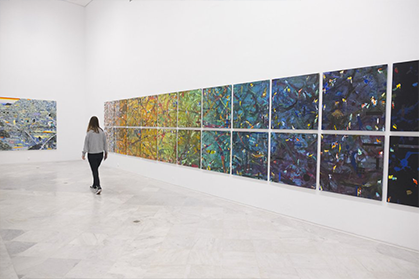
Mar de la China y Cueva Negra - EL PAIS - Paco Fuentes
Esperamos haber podido acercar a este gran artista y haber ayudado a comprender su obra y su discurso artístico. Ya solo nos queda señalar que podéis disfrutar de más obras suyas en nuestra web.
Alfonso Albacete (Málaga, 1950) is one of the most important painters of contemporary Spanish art today. His work has been exhibited in numerous museums and galleries, having the pleasure of the Ana Serratosa Gallery to be included among them.
This artist of Andalusian origin, who spent most of his childhood in Murcia, was a disciple of the artist Juan Bonafé. This, together with the fact of growing along the Levantine coast, will make light and color fundamental elements in his work.
Albacete also has a training in architecture. Although he finished his studies, he never worked professionally, as only two years after graduating he presented his first major solo exhibition in Madrid. With it he received a big critical embrace and the opportunity to dedicate himself completely to art in a professional way.
During his first years he had a brief conceptual stage, like many artists of his generation, but soon he opted for painting, where he has a prolific career.

Alfonso Albacete - El mar de la china, Dorado - Galeria Ana Serratosa
Alfonso Albacete and his generation
Alfonso Albacete belongs to a generation of Spanish painters who began their careers in the early 1970s. All of them show clear personal styles that make them easily differentiable, but there are also certain common elements.
He frequently uses a palette of vibrant colors, as well as an apolitical discourse in his works. They all bet on painting as a means of expression, referring to it with greater or lesser intensity within their work.
In the case of Albacete, the reflection on painting is constant, and has been gaining intensity over the years.

Alfonso Albacete - Destiempo 13, Primera siesta
Main features of his works
As we have already mentioned, within the generation of Alfonso Albacete there are several artists such as Villalta, Gordillo or Manolo Quejido with very clear and differentiated personal styles. Therefore we will focus on highlighting those aspects that stand out within the work of Albacete.
The author recognizes that the lighting component is one of the keys within his work. It is dominated by a white light, typical of the Spanish Levant, and more than once reminiscent of the paintings of Sorolla. Thanks to this element, Albacete manages to make us reflect on the passage of time, as well as giving the picture the vitality so characteristic of its style.
Another element to highlight is the use of a palette of vivid colors, so recurrent among his generation. Albacete tends to oversaturate this palette, as a sign of his admiration for Asian cultures such as India.
For the author, the relationship between the real and the imaginary is what occurs within the work, so his style presents that balance between figuration and abstraction that characterizes him so much.
Finally, it should be noted that the use of the human figure in his works is not direct, but symbolic. It is not intended that they become the center of attention of the picture, but a part within the message. That is why they represent faceless figures, naked or blurred, thus stripping them of the prejudices of the looking.

Alfonso Albacete - El mar de la china, cadmio - Galeria Ana Serratosa
Main artistic influences in his works
In the work of Alfonso Albacete you can find very varied references. Some are very clear and direct, such as the importance of the light of Sorolla, but others need a more calm reflection.
The artist’s father was engaged in the silk market, which meant that throughout his childhood he received visits from Asian merchants with some frequency. The impact of seeing entrepreneurs from Japan or India on a child from rural Spain in 1950 would be extraordinary, which ended up arousing an early interest of the artist for these cultures.
Oversaturated colors are a clear reflection of these cultures, which will come to express themselves more clearly in collections such as "The Sea of China", or in that dedicated to Japanese gardens.
We can also appreciate influences of abstract expressionists, with a figuration that tends to abstract, or with the clear importance of light in their works.
There are also traces of Pop Art, Duchamp or even Pollock , with the recurring brush splashes so present in his paintings.

Alfonso Albacete - Natura trece, Especulacción - 2013
Topics present in his paintings
One of the outstanding aspects of Alfonso Albacete’s work is the theme, which remains constant over the years. It shows a clear influence of his early years of conceptual art, working thoroughly on the concept and the sketch before getting to represent.
The theme that most characterizes it is the reflection on painting, whose purpose is to expand its limits. As a sample of this we find the figure of the painter’s studio that is repeated over the years. Albacete shows us the reality that occurs within the studio, the creative process that we so often tend to idealize.
Another of the elements that allude to this theme are the wild brushstrokes, or the intentional chorretones, that remind us of the raw materials with which the artist works and makes them more present.
Finally we cannot forget the metapainting that has been repeated over the years. By this we mean the fact of including old paintings in his works, which again plays with the idea of time, and the work of the artist as a creator.
It is also important to note the recurrence of landscape in his work. These landscapes involve recreations of moments or past experiences, where the horizon line is used recurrently, as well as the seashore.
Finally, we can not overlook the use of still life by means of still lifes, whether classic or more current that remains present since its inception. These still lifes work as winks for the viewer, which bring him closer to the creation process and places him in time.

Alfonso-Albacete-Variante-2016
Analysis of his most representative works
As we have already pointed out, Alfonso Albacete has a long pictorial production. That is why we wanted to comment on some of his best known works, so we can know the artist more in detail.
In the studio
In the studio it could be considered as one of the most representative works of his work, partly because it is the one that gave him to be known to a greater audience, and on the other hand because he reflects on a theme very frequent in his speech: the creative process and the figure of the painter in the process of creation.
This work is characterized by its vivid colors, by the careful use of the square that is broken by an arc that functions as a metaphor and point of union between the real and what happens in the author’s head.
It should also be noted the white stain that represents the artist, and that being undefined aims to make us think about the comings and goings of the artist on the canvas.

Alfonso Albacete - En el estudio
The Sea of China
The Sea of China is a work composed of more than 20 canvases that function as a chromatic transition, and that like many other works of the author, reflects on the same idea, hence the sense of repetition.
In it you can see a sea seen from aerial view, where some boats from the Chinese coast appear dotted. In it the author intends to reflect three realities and make us reflect on each one of them.
First there are the sea depths, a presence that can go unnoticed but that in every boat is very present. On the other hand there is the surface of the water, which changes color throughout the work, and also fruit of changes.
Finally, on this aquatic surface there are a number of elements that float, relate to it and leave a reflection on it. These are all the elements present in this work, and on which the author works repeatedly.

Mar de la China y Cueva Negra - EL PAIS - Paco Fuentes
We hope to have been able to bring this great artist closer and to have helped to understand his work and his artistic discourse. We just have to point out that you can enjoy more of his works on our website.